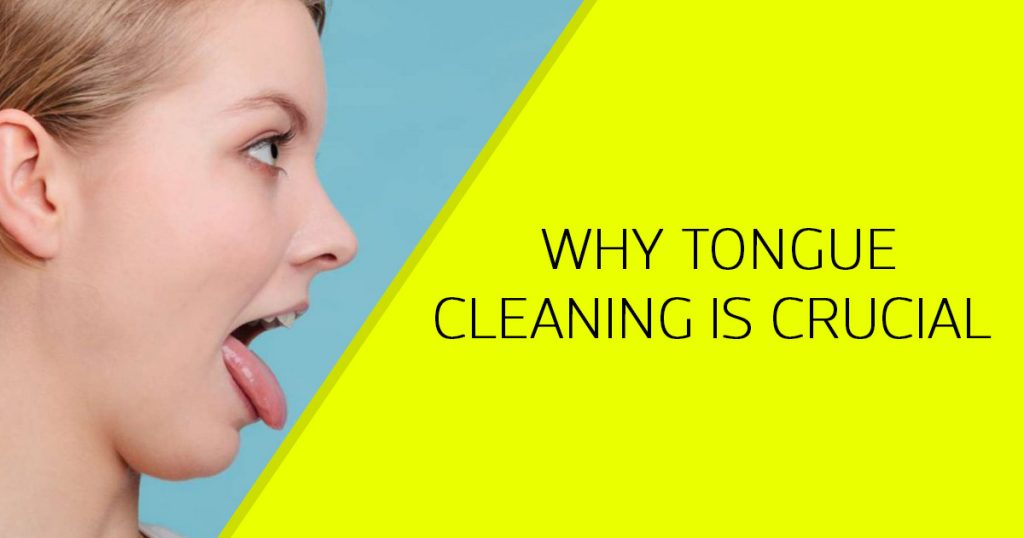Menu

It is common knowledge that the human mouth is full of microbes – approximately 20 billion at a given time! These microorganisms are responsible for causing numerous oral problems like cavities, gum disease, and bad breath. And to avoid these ailments, dentists recommend a daily routine of brushing and flossing.
While many people have a strict oral hygiene routine, the tongue is often neglected. Which is surprising considering that it harbours millions of odour-causing bacteria and dead cells! So, if you brush, floss, and rinse every day and still suffer from bad breath, not cleaning your tongue may be the reason for your predicament.
In this article, we will talk about the importance of cleaning your tongue regularly and how to do it in the most efficient manner.
The origin of bad breath (or halitosis) in 85% of the cases is inside the mouth and the tongue is the most common source of bad breath. Unless it is cleaned, bacteria accumulate on the tongue and produce hydrogen sulphide and mercaptans. These are the compounds which are responsible for foul smelling breath.
Moreover, the bacteria on your tongue can cause white discoloration of your tongue and redeposit themselves on your teeth and gums after they’ve been cleaned. This increases the chances of plaque build-up and subsequently caries and gum disease. Remember, the tongue is a crucial part of your body. It helps you taste the food you eat, speak, swallow, and more. If you do not clean your tongue regularly, it can become a source of embarrassment.
There are two widely accepted ways to clean your tongue – using a brush or a scrapper. But, are they both equally effective? Let’s find out:
If you feel your tongue, you will notice that its surface isn’t smooth. The tongue has several tiny bumps called papillae that give rise to numerous crevices and elevations. This creates space for dead skin cells, food particles, and bacteria to hide.
A tongue scraper has rigid edges that scrape away the upper layers of the debris. However, a scraper cannot reach the bacteria hidden in the crevices. So even if you clean your tongue with a scraper daily, only the uppermost cells of the bacteria are being removed.
A tongue brush, like ICPA’s Glosso on the other hand, has soft bristles that can slide between the papillae and clean out the debris by gently pushing it towards the surface. This makes a tongue brush more effective at cleaning the tongue.
Since bacteria start collecting on your teeth as soon as you finish brushing, it’s important to clean your tongue every time you brush as well. Follow the steps below to learn how to clean your tongue with Glosso Tongue Brush effectively:
Step 1: Once you’re done brushing, rinse your mouth with water.
Step 2: Take Glosso Tongue Brush and dip the bristles into 5 ml of Halyx Ultra Mouthwash. Make sure that the bristles are completely moist. One of the components of Halyx Ultra is 0.06% chlorhexidine gluconate which is known to help in cleaning bacteria.
Step 3: Now, tilt your head forward, stick your tongue out, and start brushing your tongue with the tongue brush. A gentle brushing of tongue is recommended.
Step 4: Start from the back and work forward with gentle circular motions to scrape the debris off the tongue in a few fluid motions.
Step 5: Avoid rough forward and backward motions as this may injure your tongue.
Step 6: Once you’ve brushed all parts of the tongue, finish by rinsing your mouth with water.
Dealing with Pain
If your tongue hurts while brushing or after you’re done, then you might be brushing too hard. Since the tongue is extremely delicate, brushing it the wrong way may cause inflammation. Wait for some days till your tongue heals and start brushing again with a gentle hand.
If the pain is caused by a wound or sore, then avoid cleaning the tongue until it’s healed as brushing may aggravate the problem. In case you have recurring sores or it takes too long for the injury to heal, then you must visit your dentist and discuss the course of treatment.
Dealing with Gag Reflex
Gagging is an involuntary response to something going deep down your throat. Some people have a rather sensitive gag reflex and this makes tongue brushing an unpleasant experience. Luckily, your body can get used to tongue brushing and reduce the gagging over time. Meanwhile, you can stick your tongue out as far as you can and exhale just as you feel a gag response coming. This should override the gag reflex and allow you to clean your tongue.
If you’ve been having problems with bad breath for a while, you can try our Halyx Kit. It contains all the necessary products to combat bad breath – Glosso Tongue Brush, Halyx Ultra Mouthwash, Wassup Spray, Thermoseal Proxa Interdental Brush, and sugar-free chewing gums. Make sure to visit your dentist if your bad breath persists even after maintaining oral hygiene regularly as there may be an underlying condition causing halitosis.
References


| PRODUCTS | QTY | PRICE | VALUE in INR |
|---|
| PRODUCTS | QTY | PRICE | VALUE in INR |
|---|